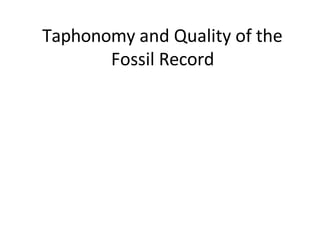
Taphonomy and Quality of the Fossil Record
- 1. Taphonomy and Quality of the Fossil Record
- 2. What is Taphonomy? • The term taphonomy was first introduced by the Russian geologist Efremov. • It referred to as the “transition of animal or plant remains from the biosphere into the lithosphere,” • The word derived from the Greek word; taphos meaning “burial” and nomos meaning “law” • This term has been variously applied to a wide range of studies in paleontology, paleoanthropology, paleoecology, and archaeology.
- 3. Taphonomic phenomena are grouped into two phases: Biostratinomy: events that occur between death of the organism and the burial; and Diagenesis : events that occur after the burial. Since Efremov's definition, taphonomy has expanded to include the fossilization of organic and inorganic materials through both cultural and environmental influences. Fields that employ the concept of taphonomy include: • Archaeobotany • Archaeology • Biology • Forensic science • Geo archaeology • Geology • Palaeoecology • Palaeontology • Zoo archaeology
- 4. Stages of taphonomy • There are five main stages of taphonomy 1. Disarticulation 2. Dispersal 3. Accumulation 4. Fossilization 5. Mechanical alteration
- 5. Decomposition Stage Descriptions of Body Stages Fresh stage Begins at death, includes rigor mortis; postmortem hypostasis and cooling; continues until bloating of the carcass is visible. Primary bloat stage Accumulation of gases within the body; no disarticulation; hair and epidermis loose; soil-skin interface gray; strong odor. Secondary bloat stage Body still bloated; disarticulation of limbs; purging; soil-skin interface black; strong odor. Active decay stage Delation of the carcass; disarticulation of the limbs and head; lesh and skin still present; carcass very wet; strong odor. Advanced decay stage Collapse of abdomen/rib cage; most of the flesh liquefied/ gone; skin, bone, fat, and cartilage may remain; carcass very wet; adipocere formation. Skeletonization Flesh, skin. Fat and cartilage disappear; some adipocere and ligaments may remain Decomposition stages and the physical appearance of remains at each stage Source: Modiied from Wilson, A. S., Janaway, R. C., Holland, A. D., Dodson, H. I., Baran, E., Pollard, A. M., and Tobin, D. J. Forensic Science International, 169, 6–18, 2007
- 6. 1. Disarticulation : occurs as the organism decays and the bones are no longer held together by the flesh and tendons of the organism. 2. Dispersal: separation of pieces of an organism caused by natural events (i.e. floods, scavengers etc.). 3. Accumulation: occurs when there is a buildup of organic and/or inorganic materials in one location (scavengers or human behavior). 4. Fossilization: when mineral rich groundwater permeates organic materials and fills the empty spaces, a fossil is formed. 5. Mechanical alteration: these are the processes that physically alter the remains (i.e. freeze-thaw, compaction, transport, burial).
- 7. Significance of taphonomy • Taphonomy is essential to understanding what the limited samples of past life mean- including biases caused by the types of organisms and habitats that are and are not represented in the fossil record. • Researchers of multiple fields to identify the past of natural and cultural objects from the time of death or burial until excavation. • Taphonomy can aid in the understanding of past environments. • Often these findings can be used to better understand cultural or environmental shifts.
- 8. Quality of the Fossil Record Quality of the fossil record depends on various physiochemical conditions. Depending on local hydrodynamic conditions, fossil accumulations may be biocoenosic or transported onshore, foreshore or offshore from the original biotope.
- 9. Sediment transport/ hydrodynamic sorting for microfossil accumulation
- 10. Chemical composition of the shell • Chemical susceptibility to diagenesis and dissolution varies with the composition of the shell. • Aragonite is less stable than calcite and, thus, aragonitic shells may be replaced by calcite. • According to Be (1977), the more solution-susceptible species (e.g. Globigerinoides ruber) are relatively small, thin-walled and have large pores compared with the less solution-susceptible species having large tests, small pores and thick walls (e.g. Globorotalia tumida)
- 11. Ranking of selected species of planktonic foraminifera in order of decreasing susceptibility to solution Rank Species Resistance 1 Globigerinoides ruber Low 2 Orbulina universa 3 Globigerinoides sacculifer 4 Globigerina bulloides 5 Candeina nitida High 6 Globorotalia inflata 7 Globorotalia menardii 8 Pulleniatina obliquiloculata 9 Sphaeroidinella dehiscens 10 Globorotalia tumida G. ruber (Rank 1) is the least resistant to dissolution and Gl. tumida (Rank 10) is the most resistant species in the given assemblage (after Berger 1970)
- 12. Type of fossil preservation on the basis of depth
